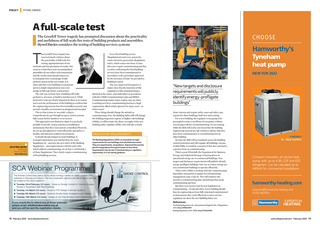




POLICY | HYWEL DAVIES A full-scale test The Grenfell Tower tragedy has prompted discussion about the practicality and usefulness of full-scale re tests of building products and assemblies. Hywel Davies considers the testing of building services systems T DR HYWEL DAVIES is technical director at CIBSE www.cibse.org he Grenfell Tower Inquiry has received much evidence about the practicality of full-scale fire testing, appropriateness of test methods, and interpretation of results. One concern is that these tests on standardised assemblies do not reflect real construction and the results need interpreting to try to anticipate how a real design would perform, based on the test results. It is often said that every building is a prototype and it is simply impractical to test every design at full scale before construction. The only way to know how a building will really perform is, of course, to build it and then test it. While destructive tests are clearly impractical, there is no reason not to test the performance of the building to confirm that the engineering systems have been installed correctly and provide a healthy environment as designed and intended. This is what is done in sea trials; a ship is comprehensively put through its paces, and its systems fully tested, before handover to its owners. This approach is not limited to ships. It is perfectly possible to test the various systems in a building to demonstrate that they work and are controlled effectively, are set up and adjusted to work efficiently, and deliver a healthy and infection-resilient environment. It should already happen to most buildings. It is a legal requirement now and has been for years. Regulation 44 and now the new 44ZA of the Building Regulations and requirements L1(b)(iii) and L2(b), which address commissioning, are in Part L of Schedule 1 of those Regulations. They clearly require commissioning of fixed building services. Every fixed building service (Regulation44) and every system for onsite electricity generation (Regulation 44ZA, which comes into force in June this year) require commissioning and that a notice confirming the fixed building services have been commissioned in accordance with a procedure approved by the Secretary of State be provided to Building Control. The new Approved Document L2 makes clear that the intention of this regulation is that commissioning is planned at the outset, and undertaken in accordance with the CIBSE Commissioning Codes and BSRIA Commissioning Guides. Some readers may say there is nothing new here: commissioning has been a legal requirement, albeit widely ignored, for many years so what is new? Three things should change the attitude to commissioning. First, the Building Safety Bill will change the building inspection regime. In higher-risk buildings (HRBs), it will be under the direct oversight of the new building safety regulator (BSR), who will take a much REGULATORY REQUIREMENTS The Building Regulations (2010, as amended) set legal requirements for new buildings and refurbishment works. They are requirements, not guidance. Approved Documents give formal guidance from government on how those requirements may be met. Commissioning is a regulatory requirement, it is not merely guidance. SCA Webinar Programme The Smoke Control Association (SCA) will be running a series of CIBSE certified CPD webinars in February and March. The four scheduled webinars are free to attend and will be hosted on the Zoom platform. l Tuesday 22nd February (12 noon) - Guide on Smoke Control to Common Escape Routes in Apartment High Rise Buildings l Tuesday 1st March (12 noon) - Guide to CFD Design of Smoke Systems l Tuesday 8th March (12 noon) - Guide to Smoke Shaft Acceptance and Testing l Tuesday 15th March (12 noon) - Design of Car Park Smoke Control Systems by CFD If you would like to attend any of these webinars please email: info@smokecontrol.org.uk and you will be sent the registration details. 12 February 2022 www.cibsejournal.com CIBSE Feb22 pp12-13 Hywel.indd 12 28/01/2022 16:03